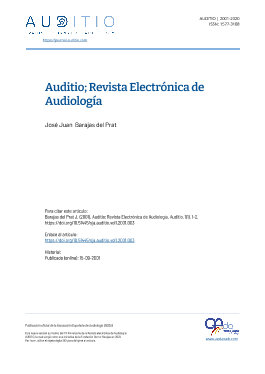Auditio; Electronic Journal of Audiology
DOI:
https://doi.org/10.51445/sja.auditio.vol1.2001.003Abstract
Scientific journals have been the communication vehicle of science since the 17th century. They have served to organize knowledge in areas of common interest and to establish a level in the quality of publications. However, at the same time they have segmented the research in a multitude of journals and made access to them more expensive. For example, a topic of study such as multiple sclerosis can be found referenced in more than 50 different journals. This, for the professional, means an investment in time and cost in the acquisition of the articles, often daunting. Subscriptions have risen 207% during the period between 1986 and 1999. Also, in that same period there has been a 55% increase in the number of the magazine. This has led publishers to unjustified price inflation in most cases. Thus, for example, the annual subscription in Brain Research costs approximately $15,000.
The development of journals in electronic format has been dizzying. The advantages are obvious, the reduction in production and distribution costs, the possibility of interaction between the reader and the author, the wide range of presentation and design that allow rapid dissemination of scientific information.
Most of the traditional scientific publications now offer their electronic version on the net. Some have even disappeared in their traditional format and are now only available electronically. There is no doubt that we are witnessing a revolution in scientific publishing in which the next 5 years will be decisive.
In Europe there are five English-language journals dedicated to audiology: Audiology, Neuro Otology and Audiology, British Audiology, Journal of Audiological Medicine and Scandinavian Audiology. The people responsible for these journals realize that maintaining a high academic standard while reducing costs requires considering the possibility of merging the publications. In recent months we are aware that there have been attempts by Scandi-navian Audiology, Audiology and British Audiology to try to form a single publication.
In Spanish, audiology journals are scarce and irregular in appearance. In general, the articles are of low academic level, reflecting the little tradition that this discipline as such has in the field of our Spanish-speaking community. The portal that we present contains, as it could not be otherwise, a fundamental part dedicated to an electronic magazine in Spanish.
From this perspective, Auditio was born, a publication dedicated to Audiology in electronic format. Our journal assumes an internationally important role as it deals with an extraordinarily broad and complex discipline. To tell the truth, Audiology could very well follow the “Cervantine” definition of knight-errantry from Don Quixote: “a science that comprehends in itself all or most of the sciences in the world”. Indeed, the audiologist must know anatomy to recognize the different structures that make up the auditory system, he must be a physiologist because he must be familiar with the intimate mechanisms of hearing. You must have knowledge of physics, especially acoustics because you have to understand the triggering stimuli. He must be a psychologist to help his patients in their rehabilitation. You have to know the different diagnostic methods because you have to establish the nature of the different audiological dysfunctions ... in short, judge yourself "yes it is a contemptible science which the knight who studies and professes it has to learn ".
Our purpose is for this electronic journal to achieve the objectives that printed journals on audiology written in Spanish have not been able to achieve so far: (1) universal distribution (2) low costs (3) regular appearance and (4) acceptable scientific level. There is no doubt that for these objectives to be achieved we need the collaboration of all. Above all, that we lose our suspicion and send our most relevant contributions to these journals that now appear in our network. That they submit with pleasure to the international reviewers of the editorial board and above all that they feel scientifically recognized in our journal. On your own behalf and on behalf of the editorial committee, we thank you for your collaboration and we warmly welcome you to the Electronic Journal of Audioiology: Auditio.
Downloads
Visibility and Altmetrics
Metrics
Global Statistics ℹ️
|
1152
Views
|
683
Downloads
|
|
1835
Total
|
|

Published
Versions
- 2021-09-15 (2)
- 2001-09-15 (1)
How to Cite
Issue
Section
License
Copyright (c) 2001 Auditio

This work is licensed under a Creative Commons Attribution 3.0 Unported License.
All articles will be published under the open Creative Commons Attribution (CC-BY) license. This license allows others to share and adapt the content, even for commercial purposes, as long as appropriate credit is given to the authors and the journal. By submitting their manuscript, authors retain copyright but grant the journal the right to make the first publication under this license.
More information about this license is available at: https://creativecommons.org/licenses/by/4.0/
Articles published between 2001 and 2020
The texts published in this journal in the section "AUDITIO 2001-2020" are subject - unless otherwise indicated - to a Creative Commons Attribution 3.0 Spain license. You can copy, distribute, communicate them publicly, make derivative works and commercial uses provided that you acknowledge the credits of the works (authorship, name of the journal, publishing institution) in the manner specified by the authors or by the journal. The full license can be consulted at http://creativecommons.org/licenses/by/3.0/es/deed.es.









